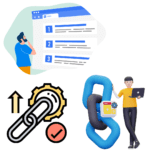How to Use Blogs for Marketing: A Comprehensive Guide.
Effective marketing strategies are essential for businesses to stay competitive. Blogging has emerged as a powerful tool to engage audiences, establish authority, and drive organic traffic to websites. This comprehensive guide will delve deep into the world of using blogs for marketing, while also emphasizing the importance of SEO optimization to maximize your online reach and impact.
Understanding the Power of Blogging for Marketing
Building Authority
Blogs serve as platforms for sharing expertise and knowledge. To build authority through blogging:
Consistency: Publish regularly to establish credibility. Readers trust sources that consistently deliver valuable content.
In-Depth Content: Dive deep into industry-specific topics, providing insights that set you apart as an expert.
Cite Sources: Support claims with credible sources, reinforcing your credibility.
Boosting SEO
Blogs play a pivotal role in search engine optimization (SEO):
Content Relevance: Regularly updated blogs provide fresh, relevant content that search engines favor.
Keyword Optimization: Conduct keyword research to identify phrases relevant to your niche. Use them naturally in titles, headers, and body content.
User Experience: Engaging blog posts encourage longer time spent on your site, which can boost SEO.
Engaging Your Audience
Engagement is vital for nurturing leads and customer loyalty:
Audience-Centric Content: Understand your audience’s pain points and questions. Tailor content to address their needs.
Interactivity: Encourage comments, questions, and social sharing to foster a sense of community.
Call to Action (CTA): Include clear CTAs to guide readers toward desired actions, such as subscribing or making a purchase.
Setting Up Your Blog for Success
Choose the Right Platform
Selecting the appropriate blogging platform is crucial:
WordPress: Offers customization and versatility, making it a top choice for most businesses.
Blogger: Ideal for beginners due to its user-friendly interface.
Medium: Simplifies content creation and provides access to a built-in audience.
Optimize for Mobile
Mobile optimization is imperative:
Responsive Design: Ensure your blog adapts seamlessly to different screen sizes.
Mobile-First Indexing: Google prioritizes mobile-friendly websites in search results.
Branding
Consistent branding reinforces your identity:
Logo: Use a recognizable logo that represents your brand.
Color Scheme: Stick to a consistent color palette across your blog and other digital assets.
Content Creation Strategies
Keyword Research
Effective content starts with keyword research:
Tools: Use keyword research tools like Google Keyword Planner or SEMrush to find relevant keywords.
Long-Tail Keywords: Target specific, less competitive long-tail keywords to attract niche audiences.
High-Quality Content
Craft content that captivates readers:
Research: Invest time in thorough research to provide accurate and valuable information.
Formatting: Use headers, bullet points, and visuals to break up text and enhance readability.
Storytelling: Weave stories into your content to engage readers emotionally.
Content Calendar
Plan content strategically:
Consistency: Maintain a regular posting schedule to keep readers engaged.
Variety: Include a mix of content types, such as how-to guides, case studies, and opinion pieces.
SEO Optimization
Maximize your blog’s search engine visibility:
On-Page SEO
Optimize individual blog posts for SEO:
Keyword Placement: Use relevant keywords naturally in titles, headers, and body text.
Meta Titles and Descriptions: Craft enticing meta titles and descriptions to improve click-through rates from search results.
Meta Descriptions
Compelling meta descriptions boost organic traffic:
Conciseness: Keep descriptions under 160 characters while conveying the content’s essence.
Actionable Language: Include a call to action to encourage clicks.
Internal Linking
Enhance user experience and SEO through internal links:
Relevance: Link to related blog posts or pages to provide additional value to readers.
Anchor Text: Use descriptive anchor text to give context to the linked content.
Image Optimization
Improve image SEO:
Alt Text: Add descriptive alt text to images for accessibility and SEO.
File Size: Compress images to reduce page load times.
Promotion and Distribution
Ensuring your blog content reaches your target audience is key:
Social Media
Leverage social media for promotion:
Consistency: Share blog posts across your social channels to broaden your reach.
Engagement: Interact with your audience by responding to comments and questions.
Email Marketing
Integrate blog content into email campaigns:
Teasers: Include snippets of blog posts in newsletters to entice subscribers.
Segmentation: Tailor content to different subscriber segments for relevance.
Guest Posting
Collaborate with influencers and other blogs:
Networking: Build relationships within your industry by contributing guest posts.
Audience Expansion: Tap into the existing audiences of other blogs to reach new readers.
Analyzing and Measuring Success
Monitor and adjust your strategy based on data:
Google Analytics
Use Google Analytics for valuable insights:
Traffic Sources: Identify where your traffic is coming from.
Conversion Tracking: Measure blog-driven conversions, such as form submissions or product purchases.
Key Metrics
Monitor essential metrics:
Organic Traffic: Track how many visitors come from organic search results.
Click-Through Rates: Measure the percentage of users who click through to your blog posts.
Bounce Rates: Assess how effectively your content keeps users engaged.
Social Shares: Gauge the virality of your content.
A/B Testing
Experiment and refine your strategy:
Headlines: Test different blog post headlines to determine what resonates best with your audience.
Content Types: Explore various content formats, such as videos, infographics, and podcasts.
Feedback Loop
Listen to your audience:
Comments and Feedback: Pay attention to comments on your blog and social media for insights.
Surveys and Polls: Conduct surveys to gather feedback directly from your audience.
Stay Updated
Keep abreast of industry changes:
Algorithm Updates: Monitor search engine algorithm changes and adjust your SEO strategy accordingly.
Trends: Stay informed about industry trends and incorporate them into your content strategy.
In Conclusion
Harness the Blogging Power
Blogging for marketing is a dynamic and impactful strategy when executed strategically. Through consistency, quality content, SEO optimization, and thoughtful promotion, your blog can become a cornerstone of your digital marketing efforts. Success in blogging requires dedication, patience, and a commitment to evolving alongside the ever-changing digital landscape.
Start your blogging journey today and unlock the full potential of this valuable marketing tool. With the right approach, your blog can drive growth, establish authority, and foster customer loyalty for your business






